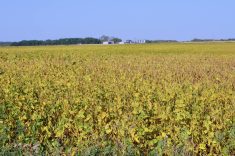FUTURES | Canola also remains subject to the Chicago soy complex’s complexities
Any hopes of canola getting a bounce on ICE Futures from Statistics Canada’s production report on Aug. 30 were largely dashed. The Canadian oilseed, for the most part, remained lower in the aftermath of the long-awaited report.
The pattern repeated itself for a few days; for most of a session canola was pulled down by weakness in Chicago Board of Trade soyoil, and as each daily session wound up, soyoil would come well away from its lows, which lent strength to canola. By the time trading ceased for the day, canola would see small increases for its front months while the more deferred positions still fell back, but still nowhere near their earlier declines — although the pattern reversed at the close on Sept. 2.
With the severe drought across the Prairies this summer, it was a given that production, of canola, and other crops, would drop sharply. Extreme heat and dryness forced grains, oilseeds and pulses to mature much earlier than normal, with far fewer seeds to be harvested.
Other than for any late-developing crops, recent rains across the Prairies weren’t much of a help. The much-needed precipitation did replenish topsoil and subsoil moisture levels, but to a point. For canola, the rain only delayed harvesting.
Projections from much earlier this year forecast the 2021-22 canola crop at a little more than 20 million tonnes, an increase over the 19.48 million tonnes from the previous year. As fate would have it, that 20 million quickly vanished with the non-existent summer rains. Traders and analysts lowered their expectations, with 17 million tonnes as the best-case scenario — and thoughts of as little as 11 million tonnes at the low end.
Based on data gathered in July, Statistics Canada on Aug. 30 made its call of 14.75 million tonnes. Normally such a steep drop would generate sharp gains in the market, but while the federal agency’s number was within the range of trade guesses it was a little above the average prediction. That created a bearish reaction and canola prices for the front months dipped.
Added to the report, continuing weakness in soybean oil kept a tight lid on any major spikes canola might have otherwise received.
As some in the trade said, canola is expensive relative to soyoil. No matter how tight supplies are now and in the foreseeable future, that gap between canola and soyoil can get only so big. Price rationing is part of canola for the time being — but its effects are constrained by the shifts in soyoil.




















